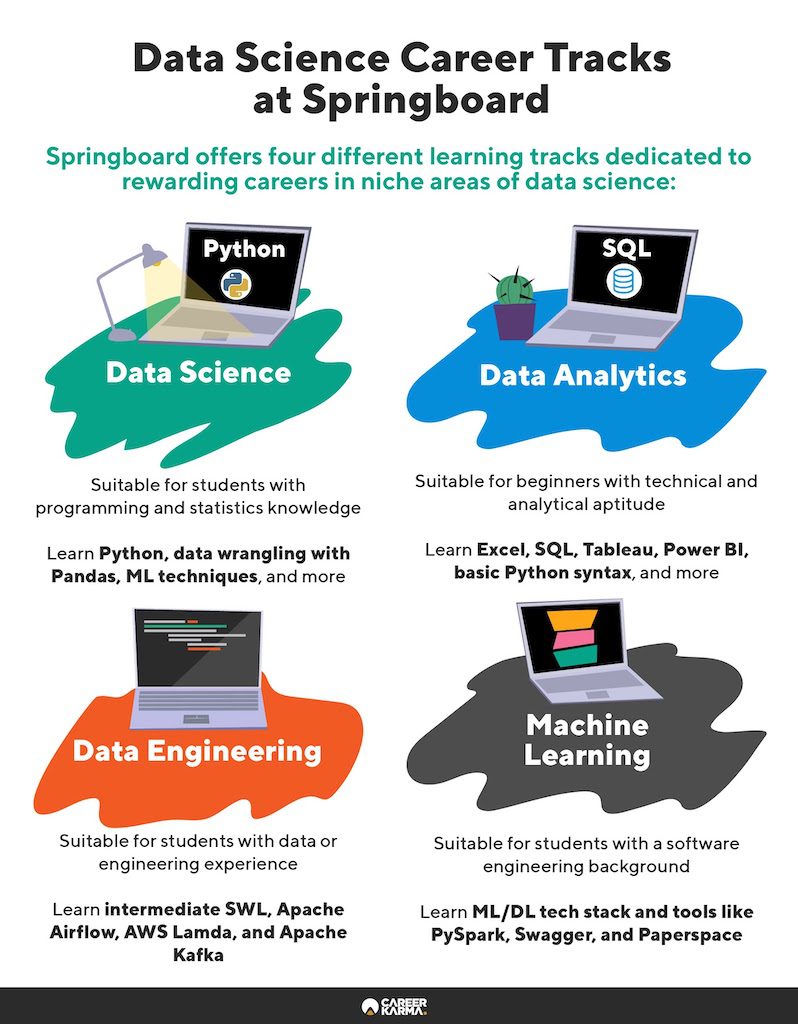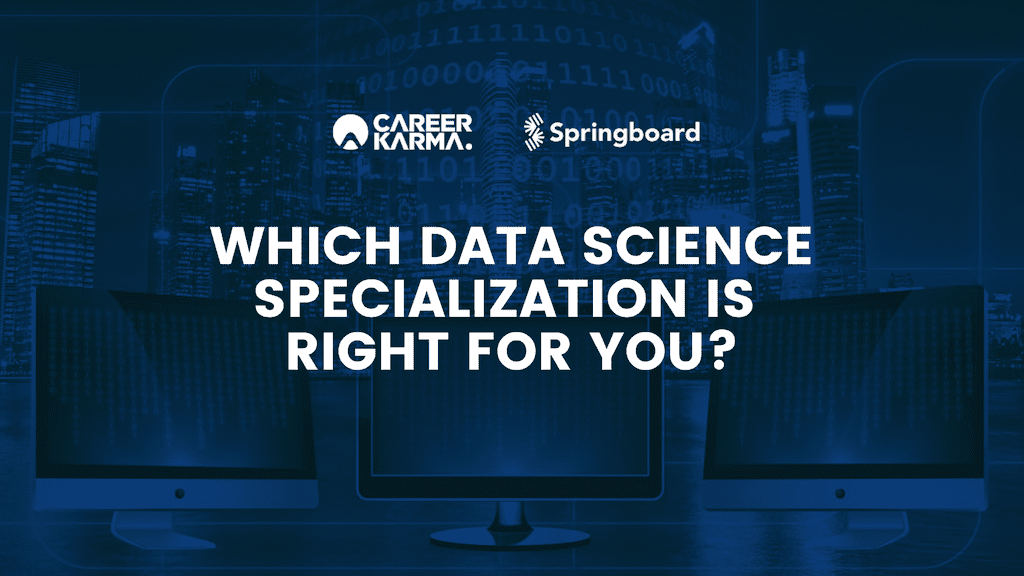Data science is a deep and diverse industry that many people are interested in but may not fully understand. This is unsurprising because companies and organizations often use the terms data scientists, data analysts, and data engineers interchangeably. In recent years, machine learning has also made its presence felt in the data science world, adding to the confusion.
What’s clear is that the field of data science continues to grow, both in popularity and necessity. Data has become the backbone of business decision-making. In terms of employment opportunities, the US Bureau of Labor and Statistics predicts that data science jobs will grow 16 percent between 2018 to 2028, faster than the average of other occupations. These indicate that the increasing demand for data scientists shows no sign of slowing down.
Springboard offers data science courses with a strong mentorship program and job guarantee.
Take Springboard’s quiz here.Springboard’s Data-Focused Courses

Springboard is a coding bootcamp that offers data science, data analytics, data engineering, and machine learning courses. Although there is some natural overlap between the courses, each course opens doors to distinct career paths. If you are interested in data science but are unsure of which Springboard career track fits you best, let’s take a closer look at each of them.
Data Science Career Track
Springboard’s Data Science Career Track course is best for people who have a background in statistics and are familiar with programming. In this course, students will learn the following skills:
- Python and its standard libraries
- Master the basics of inferential statistics and parameter estimation
- Analyze data and build predictive models to generate insights
- Present insights effectively to business stakeholders
- Work with engineers to implement models
Python is the standard language of data science. Students will learn how to build learning models to help predict the future through a machine learning Python DS stack, including Pandas, statsmodels, and scikit-learn.
Springboard also offers a data science prep course that students can attend before taking this track. Those who complete this course can take on the roles of data scientist and data analyst.
Data Analytics Career Track
Students who take the Data Analytics Career Track course should possess the technical and analytical aptitude and do not need to know how to code. Data analytics students will learn how to do the following:
- Perform data analysis to extract business insights
- Translate business problems into data problems
- Convey key insights and recommendations to pertinent stakeholders
Graduates can become data analysts, product analysts, and business analysts. This course uses and teaches Excel, SQL, Tableau, and Power BI. The data analytics course also introduces students to basic Python syntax giving graduates an edge over other data analysts in the job market.
Data Engineering Career Track
The Data Engineering Career Track course requires six months or more experience in a data or software engineering role. In this course, students will design, build, and maintain scalable data pipelines. Students of this course will learn how to:
- Work with Hadoop and Spark
- Design data streams and API
- Data warehousing and modeling using intermediate SQL
- Build data pipelines using cloud solutions, virtualization, and containers
Students will also learn how to use Apache Airflow, AWS Lambda, and Apache Kafka and work with data scientists and data analysts. This course is ideal for technical people who want to work as data engineers and analytics engineers after graduation.
Machine Learning Engineering Career Track
This course prepares students to take on the roles of machine learning engineer, data scientist, AI applications engineer, and deep learning engineer. The Machine Learning Engineering Career Track course will require students to learn machine learning systems and take a machine learning model and deploy it to production. It teaches students the following skills:
- Build systems to deploy ML/DL models to production, to be used by millions of users
- Design an ML/DL based approach to a complex data problem
- Implement tune and scale ML/DL models
Students need software programming experience before taking this course. The course will teach students the foundations of machine learning and deep learning (ML/DL) tech stack. They’ll also learn other advanced concepts and tech tools, including PySpark, Swagger, and Paperspace.
All data science courses take between 500 to 600 hours to complete. They also offer career support services and come with a job guarantee. Each course and specialization fall under the broad umbrella of data science, but they have their unique career paths. Depending on your interests and where your professional and career goals lie, you can choose which learning path fits you best.
Building a Data Career with Springboard
It’s never too late to make a career switch and start a new career in data science. Melanie Butler’s background lies in chemistry, including a master’s degree in computational and experimental chemistry. During her graduate studies, she experienced coding, which sparked her interest in data science.
“After my master’s, I took a break from science and went into teaching high school. I loved teaching high school and my students. After about four years, I started teaching computer science and began dipping my toes back into computations and coding. Subjects I never got to delve into deeply. It reminded me of how much I loved it, and I wanted to learn more about it,” Melanie said.
“As much as I enjoyed teaching, I wanted to be doing them myself on a deeper level. That’s when I decided to quit teaching, but I didn’t want to do another degree. What’s a way I can quickly and efficiently learn some of these skills, rather than another university program?” she continued.
This question led her to Springboard’s Data Science Career Track course.
Why Students Choose Springboard
Melanie chose Springboard for several reasons.
“First, the job guarantee. I liked that they were putting their money where their mouth was, in terms of the quality of their program. They were willing to guarantee that if you work hard and you complete the program, they have confidence that you’ll be able to find a job,” she said.
“It was hard for me to tell who had a quality program and who didn’t. The job guarantee was a big indicator of confidence for me.”
“Next, the mentorship. Not all the programs I looked at had a mentorship component, which seemed really valuable. When I read student reviews, the availability of a personal mentor was consistently mentioned as one of the strengths of the program,” Melanie added.
She also shared her thoughts about how the Springboard data science career track course was presented and laid out.
“The first half of the program was very strong. I felt that the base curriculum was really well-designed. One great aspect of the program that I used and helped me a lot was the Slack channel with all of the students on it. I was able to build relationships there and meet some really cool people. If I had questions, we would discuss them there, and we’d have some workgroups on it.”
“Now and then, there would be an assignment that needed clarification. The Slack channel was important because we were free to give feedback about the assignments. There was a Springboard community manager who would receive the feedback and look at the assignment. If they also felt that the assignment needed revisions, they would re-work it,” Melanie continued.
Life After Springboard
Melanie currently works at Northwestern University as a data scientist in its Alumni Relations and Development Division. “I started as a part-time, temporary analyst. At that time, they just needed someone to help with this massive load of reports that they were dealing with. I found an opportunity to try and automate the process using Python.”
“They were manually re-running a lot of these reports. I built a simple workflow using Python to automate it. My boss was great and said, ‘It’s awesome that you can do this. Would you be interested in joining the team?’ That’s how I ended up working full-time after a few months,” Melanie shared.
She credits Springboard in preparing her for her current role as a data scientist. “It definitely helped prepare me. I know I still have much to learn because I see myself as a baby data scientist just getting started. However, I feel like the basics of technical skills are there. I know enough to research the things I need to learn more and make headway on them on my own.”
“I also know how to be more effective when collaborating with other people. I was able to use my learning experience at Springboard to build a couple of models independently,” Melanie continued.
A typical workday for a data scientist can change depending on what is needed. “It changes a lot from day to day because of the nature of the team that I’m on. We’re still building the data science component of our team. Sometimes, I have weeks when I’m working on products that we’ve already set up. Other times, I’m working more on the reporting side of things, maintaining the automation that I’ve set up, and more descriptive analytics and reporting.”
Tips for Aspiring Springboard Students
Melanie shared some important advice for people interested in Springboard’s data science course. “The biggest thing for me was that if I was going to do it, I was going to commit to it and dedicate myself to it for the whole time I was at the program. Also, take advantage of what is offered as much as possible.”
“For instance, with the capstone projects, I probably put more time into the projects than they recommended. I wanted to learn a lot doing them, and I wanted to make them as good as possible. Another tip is to take advantage of the online community on the Slack channel. Not every student was active on the channel, but for me, it was very valuable, and I would really recommend that,” Melanie said.
Melanie believes that graduates should consider all their strengths and be open to initially taking a job that may not be explicitly data science. She also has some insights about looking for a data scientist position. “For me, I accepted a part-time temp job while I was still at Springboard, and it was not a data science job. Then I tried to show them what I could do while I was there.”
“After, they said, ‘We can use this, this is awesome, let’s try to make this work for you.’ This was when I was able to get a position as a data scientist. Look for ways that you can get yourself in the door, but also push to show what you’ve learned and how it can be useful,” Melanie shared.
Melanie’s experience working as a data scientist can serve as a guide and an inspiration for people looking to enter data science. When you decide that you want to work in data science, Springboard’s specialized courses can give you the start you need and equip you with the foundational skills you need for career growth.
Choose the Right Data Science Course For You
Springboard’s data science courses can give you the tech skills you need to have a fulfilling career in data-intensive industries, may that be in data analytics, data science, data engineering, or machine learning.
If you’re ready to start your data science career, join thousands of other graduates who have completed courses at Springboard. Learn more about their data science offerings and take this quiz to find out which Springboard course is right for you.
About us: Career Karma is a platform designed to help job seekers find, research, and connect with job training programs to advance their careers. Learn about the CK publication.




